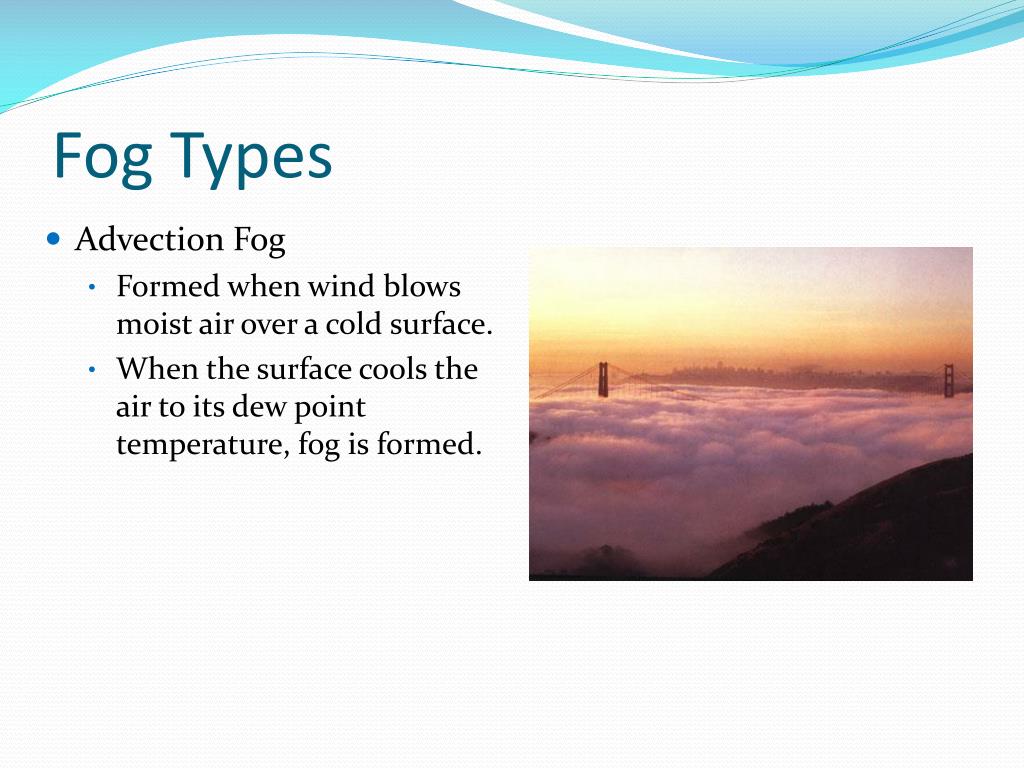

Small temperature-dew point spread is essential for fog to form. It is primarily a hazard during takeoff and landing, but it is also important to VFR pilots who must maintain visual reference to the ground. It is not unusual for visibility to drop from VFR to less than a mile in a few minutes. The rapidity with which fog can form makes it especially hazardous. Fog is the most frequent cause of surface visibility below 3 miles, and is one of the most common and persistent weather hazards encountered in aviation. The sum of these processes is called convection.Fog is a surface based cloud composed of either water droplets or ice crystals. Note that as it moves downstream, the "pulse" of ink will also spread via diffusion. If added to a lake without significant bulk water flow, the ink would simply disperse outwards from its source in a diffusive manner, which is not advection. As the river flows, ink will move downstream in a "pulse" via advection, as the water's movement itself transports the ink. One easily visualized example of advection is the transport of ink dumped into a river. It is derived using the scalar field's conservation law, together with Gauss's theorem, and taking the infinitesimal limit. The advection equation is the partial differential equation that governs the motion of a conserved scalar field as it is advected by a known velocity vector field. The advection equation also applies if the quantity being advected is represented by a probability density function at each point, although accounting for diffusion is more difficult. Advection is important for the formation of orographic clouds (terrain-forced convection) and the precipitation of water from clouds, as part of the hydrological cycle. In meteorology and physical oceanography, advection often refers to the horizontal transport of some property of the atmosphere or ocean, such as heat, humidity or salinity, and convection generally refers to vertical transport (vertical advection). Because of the specific use of the term convection to indicate transport in association with thermal gradients, it is probably safer to use the term advection if one is uncertain about which terminology best describes their particular system. Thus, although it might seem confusing, it is technically correct to think of momentum being advected by the velocity field in the Navier-Stokes equations, although the resulting motion would be considered to be convection. More technically, convection applies to the movement of a fluid (often due to density gradients created by thermal gradients), whereas advection is the movement of some material by the velocity of the fluid. The term advection often serves as a synonym for convection, and this correspondence of terms is used in the literature. In meteorology and physical oceanography, advection often refers to the transport of some property of the atmosphere or ocean, such as heat, humidity (see moisture) or salinity.Īdvection is important for the formation of orographic clouds and the precipitation of water from clouds, as part of the hydrological cycle.ĭistinction between advection and convection It does not include transport of substances by molecular diffusion.Īdvection is sometimes confused with the more encompassing process of convection, which is the combination of advective transport and diffusive transport. Advection requires currents in the fluid, and so cannot happen in rigid solids. The fluid's motion is described mathematically as a vector field, and the transported material is described by a scalar field showing its distribution over space. In general, any substance or conserved, extensive quantity can be advected by a fluid that can hold or contain the quantity or substance.ĭuring advection, a fluid transports some conserved quantity or material via bulk motion. Here the fluid may be any material that contains thermal energy, such as water or air. Another commonly advected quantity is energy or enthalpy. An example of advection is the transport of pollutants or silt in a river by bulk water flow downstream. The properties that are carried with the advected substance are conserved properties such as energy.

Generally the majority of the advected substance is also a fluid. The properties of that substance are carried with it.

In the field of physics, engineering, and earth sciences, advection is the transport of a substance or quantity by bulk motion of a fluid. JSTOR ( May 2022) ( Learn how and when to remove this template message).Unsourced material may be challenged and removed. Please help improve this article by adding citations to reliable sources. This article needs additional citations for verification.


 0 kommentar(er)
0 kommentar(er)
